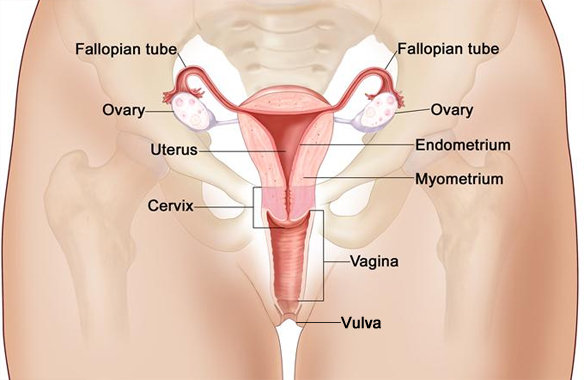Prolapsed Uterus – Symptoms, Causes and Treatment

Introduction
The uterus or womb is a muscular structure that is normally held in place inside a woman’s pelvis by various muscles, tissues and ligaments. Due to pregnancy, childbirth, difficulty during labour and delivery, or other various reasons, these muscles and ligaments become weak and are no longer able to support the uterus causing a prolapsed uterus, also known as uterine prolapse. A uterine prolapse occurs when the uterus sags or slips from its normal position and into the vagina, or birth canal.A prolapsed uterus can be either complete or incomplete. A complete uterus is when the uterus falls so far down that some tissue rests outside the vagina. An incomplete prolapse occurs when the uterus is only partly sagging into the vagina.

Symptoms
Women with minor uterine prolapse may not have any symptoms, but those with moderate to severe prolapse may experience symptoms such as:
- A feeling like you’re sitting on a ball
- Vaginal bleeding
- Increased discharge
- Problems during sexual intercourse
- Visible uterus or cervix through the vagina
- A heavy or pulling feeling in the pelvis
- Constipation
- Recurrent bladder infection
See a gynaecologist or obstetrician if you experience the above mentioned symptoms. You can find some of the best obstetrician/gynaecologist specialist in India.
Causes
Weakening of pelvic and other supportive tissues are main causes. Causes of these include:
- Pregnancy
- Difficult labour and delivery or trauma during childbirth
- Delivery of a large baby
- Being overweight or obese
- Lower oestrogen level after menopause
- Chronic constipation or straining with bowel movements
- Chronic cough or bronchitis
- Repeated heavy lifting
Treatment
Not all instances of a prolapsed uterus require treatment, but a doctor’s advice is necessary. Treatment, if and when needed, includes:
- Nonsurgical treatments, which include:
- Losing weight to take the stress of the pelvis and the structures in it
- Avoiding lifting heavy objects
- Kegel exercises, which are a group of exercises that strengthen the pelvic and core muscles, as well as the vaginal muscles
- Oestrogen replacement therapy
- Using a pessary, which is a device inserted into the vagina that fits under the cervix and helps push up and stabilize the uterus and cervix
- Surgical treatments include:
- Uterine suspension
- Hysterectomy
Surgery, however, is not recommended for woman who want to have children in the future.
You can find specialized gynaecology hospitals in Gurgaon and Delhi NCR, as well as in Patna in Bihar. These are multi-specialty hospitals having specialized departments for different specialities like gynaecology, gastroenterology, cancer care, neurosurgery and the like. There are such hospitals in Gurgaon and Delhi NCR, such hospitals in Patna, and one such hospital in Darbhanga in Bihar.Post Your Ad Here

Comments